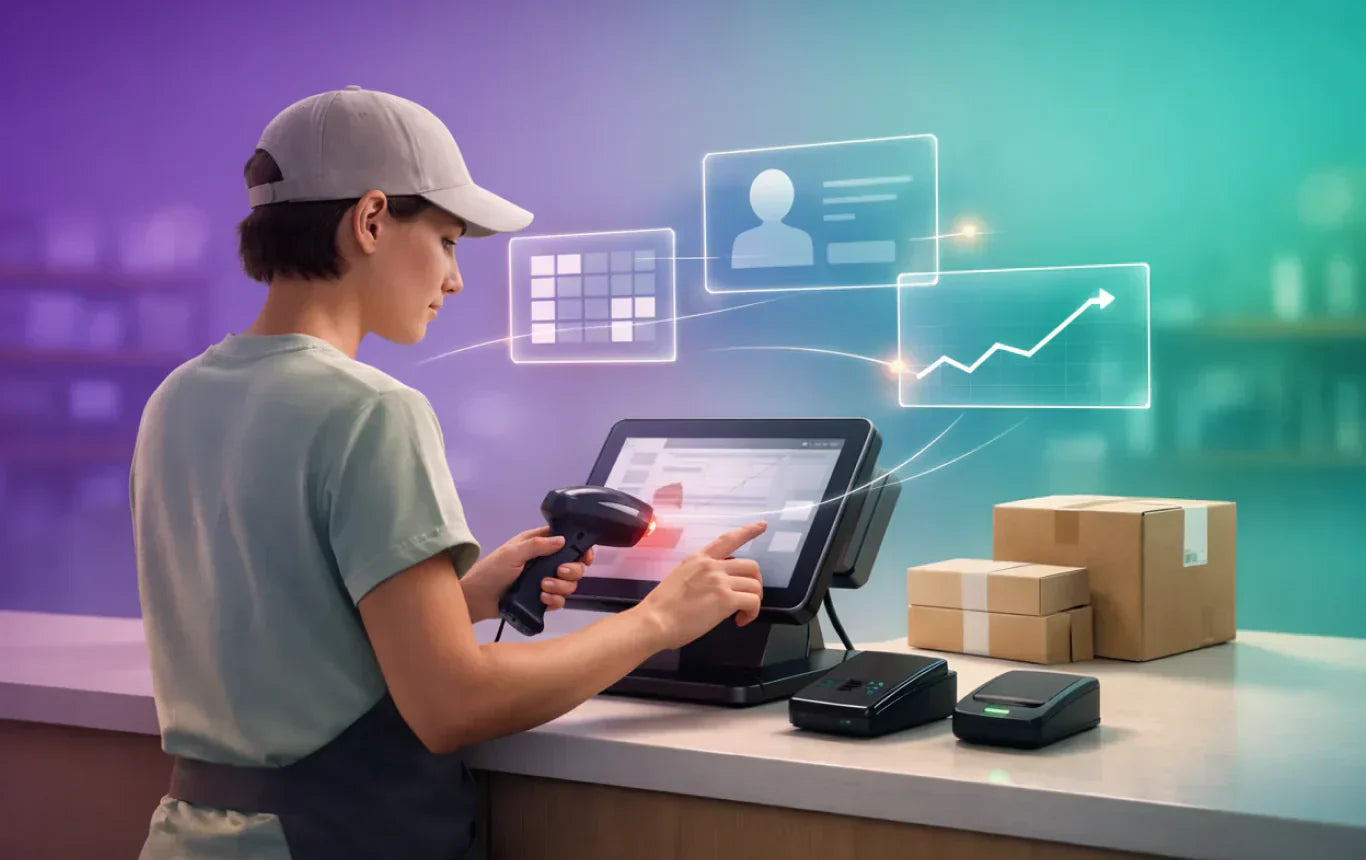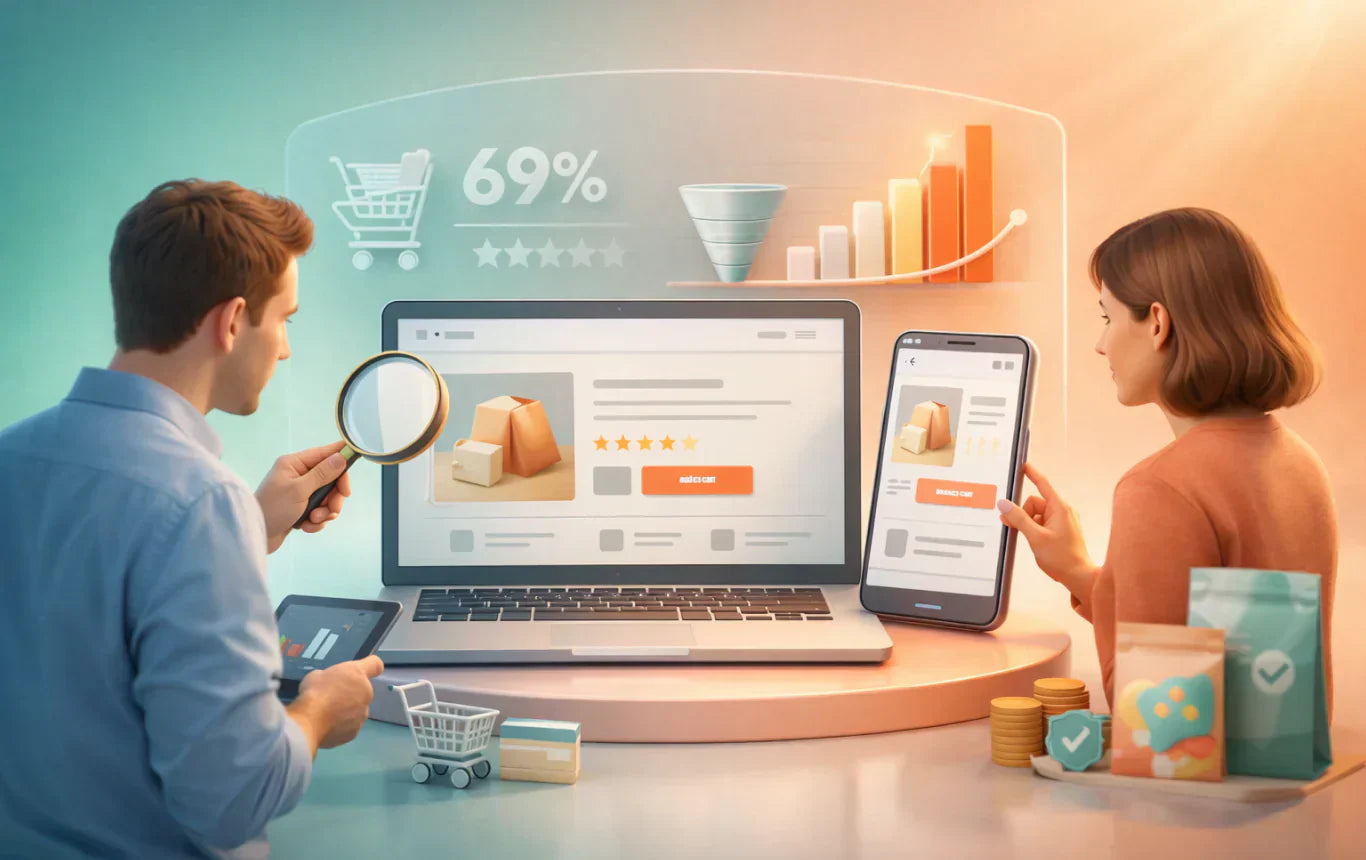Table of Content
TL;DR
We studied 30 real Shopify stores to demystify CRO. The result? Clear patterns, proven wins and common mistakes killing conversions. Learn what CRO really means, how AI is reshaping it and which strategies actually work. If you’ve got traffic but low sales, this blog is your wake-up call.
The Dr. Shopify is in. And today’s prescription? Real conversion science, not just pretty themes. If your Shopify store is getting traffic but not sales, it’s not your products. It’s your conversion rate. And yes, that can be fixed.
We ran a deep CRO diagnostic on 30 Shopify stores across niches, from skincare to survival gear and the results were revealing. Conversion Rate Optimization (CRO) isn’t just a buzzword; it’s the lever that turns browsers into buyers. In this blog, we’ll break down how CRO really works, what makes it powerful and why your store might be leaking revenue you didn’t even know existed.
What Is CRO and Why It Matters
Conversion Rate Optimization (CRO) is the process of improving the percentage of website visitors who take a desired action, typically making a purchase. In Shopify terms, it’s about turning your current traffic into actual revenue without spending more on ads.
Most merchants think of CRO as “fixing” design, but the real engine runs deeper. CRO works by analyzing user behavior, identifying drop-off points, testing hypotheses and applying changes that result in more conversions. It’s science meets psychology meets eCommerce.
On average, the Shopify stores we analyzed were losing 67% of ready-to-buy users to friction they didn’t even see.
The Shopify CRO Process: What We Actually Did

For this study, SANOMADS ran a standardized CRO audit across 30 stores. We used a consistent framework to uncover bottlenecks and opportunities:
-
Behavioral Analysis:
We employed tools like heatmaps and scrollmaps to visualize where users clicked, lingered, or ignored on a page. Session recordings allowed us to watch anonymous customer journeys, pinpointing moments of confusion or frustration that led to abandonment. This gave us a granular view of actual user interaction.
-
Technical Audit:
Our team rigorously assessed elements like website load speed, especially on mobile devices, which proved crucial for retaining impatient users. We also examined overall mobile responsiveness and the user interface (UI) flow, ensuring navigation was intuitive and free of technical glitches. A smooth technical experience forms the backbone of good CRO.
-
Funnel Mapping:
This involved charting the complete customer journey, from initial entry points on the site to the final purchase or abandonment. By identifying where users entered your sales funnel and, more importantly, where they dropped off, we could pinpoint critical leakage points and understand the underlying reasons for non-conversion.
-
User Testing:
We put real users through structured tasks on the stores, observing their interactions and listening to their feedback. This invaluable qualitative data helped us spot subtle friction points, clarify confusing elements and confirm behavioral patterns that quantitative data alone might miss. It's like having a customer walk you through their exact experience.
-
AI Personalization Potential:
We specifically looked for opportunities where static content could be replaced with dynamic, AI-driven elements. This included assessing where personalized product recommendations, adaptive layouts, or intelligent pop-ups could enhance the user experience and directly boost conversion rates. Integrating AI offers a powerful, data-driven layer of optimization.
Every step was backed by data and every recommendation we made was designed to increase Shopify conversions in measurable ways.
What We Found: Common Conversion Killers

Despite industries and audiences varying wildly among the 30 stores, the same mistakes appeared across the board, acting as significant barriers to conversion:
-
Generic product pages with no social proof or urgency:
Many stores displayed products without a single customer review or testimonial, failing to build trust. There was also often a lack of urgency, such as low stock indicators or limited-time offers, which are crucial motivators for immediate purchase. This left potential buyers feeling uncompelled and without social validation.
-
Slow load speeds on mobile and image-heavy pages:
Mobile users, in particular, abandon sites quickly if pages don't load within a few seconds. We found numerous instances where large, unoptimized images and heavy scripts drastically slowed down mobile Browse, especially on product pages, creating immense friction for impatient shoppers. This directly translated to high bounce rates.
-
No CRO strategy; merchants guessing instead of testing:
A prevalent issue was the absence of a systematic approach to optimization; merchants were making design changes based on intuition rather than data. Without consistent A/B testing or a structured hypothesis-driven process, improvements were often accidental or non-existent, leaving significant conversion potential untapped.
-
Overstuffed menus with unclear navigation paths:
Many stores cluttered their navigation with too many categories or confusing labels, overwhelming visitors. This made it difficult for users to quickly find what they were looking for, leading to frustration and premature exits from the site. Simplicity and intuitive organization are key for user flow.
-
Misaligned messaging between ads and landing pages:
We frequently observed a disconnect where the promises or products advertised in paid campaigns didn't directly match the content on the landing page users arrived at. This created immediate confusion and distrust, causing high bounce rates as users felt misled and quickly left the site. Consistency is paramount for conversion.
Stores that fixed even 3 of these issues saw an average 22% lift in conversions within 4-6 weeks.
AI + CRO: A Smarter Way to Optimize Shopify

If you’re wondering where AI fits into conversion rate optimization, here’s the answer: everywhere. AI Conversion Rate Optimization uses machine learning to predict user behavior and personalize the experience in real-time, delivering hyper-relevant content to each individual. Think of it as your ultimate digital sales assistant, constantly learning and adapting:
-
Smart product bundles based on purchase history:
Instead of static bundles, AI analyzes a customer's past purchases and Browse behavior to suggest highly relevant complementary products. This intelligently encourages higher average order values by presenting offers that truly resonate with individual needs.
-
Exit-intent popups tailored to the exact item in a cart:
When a user shows signs of leaving, AI can trigger a personalized pop-up offer or message, specifically referencing the items they almost abandoned. This precise, context-aware intervention significantly increases the chances of converting a hesitant buyer before they leave the site.
-
Dynamic headlines or hero images that adapt to user segments:
AI can identify specific user segments (e.g., first-time visitors, returning customers, discount seekers) and dynamically change the main headline or hero image on your homepage. This ensures that the most compelling visual and textual content is presented to each visitor, maximizing initial engagement.
We used AI to test variations 4x faster than traditional A/B methods and uncovered micro-conversions (like engagement with bundles or video blocks) that human-only teams would miss, proving AI's superior analytical power.
AI Personalization & CRO: Boost Shopify Conversions
Real Shopify CRO Case Example

One of the stores in our study was AdventureWell Outdoors. Before working with SANOMADS, they had strong products but were stuck under $1,000/month in sales. Our CRO case study Shopify analysis revealed significant friction points. Below is the detail:
Platform: Shopify
Industry: Freeze-Dried Backpacking Meals
Market: United States
Scope: Conversion Rate Optimization with focus on AOV
Challenges:
Adventure Well Outdoors was struggling with a poor mobile experience, low conversion rates and a lack of engaging product presentation, all of which were limiting their growth.
The Approach:
We focused on mobile-first CRO strategies to enhance usability and drive more conversions, while aligning design with the outdoor adventure niche.
Key Features We Added:
-
Visually stimulating Mega Menu
-
Sticky Add-To-Cart button
-
Post-purchase upsell
-
Optimized mobile layouts
-
High-quality visual assets
-
Enhanced product filtering
The Results:
-
3X increase in conversions
-
4.5X boost in total sales
-
28% improvement in mobile engagement
Client Review:
“We were struggling with our website’s performance, but after partnering with SANOMADS for CRO, the results were immediate. Our conversions increased dramatically and our sales improved. Their team knows how to turn a website into a powerful sales machine!”
How Shopify CRO Agencies Drive Results (Better Than DIY)

While some merchants attempt DIY optimization, our study highlighted why partnering with a dedicated Shopify CRO agency consistently drives superior results:
-
Tool access:
Agencies invest in and have expertise with advanced, often expensive, platforms like Hotjar, Crazy Egg, VWO and sophisticated AI testing engines. These tools provide deep insights and capabilities that are typically out of reach or too complex for individual merchants to manage effectively.
-
Specialized experience:
CRO is a highly nuanced field. Agencies possess a wealth of specialized experience accumulated from working with numerous Shopify stores across various niches. They inherently know what strategies and tactics truly work (and what doesn't) within the Shopify ecosystem, avoiding costly trial-and-error for you.
-
A/B testing at scale:
Effective CRO requires running multiple tests simultaneously, sometimes involving 20+ variations to pinpoint optimal solutions. This level of comprehensive and simultaneous A/B testing isn’t feasible for a solo merchant to manage efficiently, whereas agencies have the infrastructure and expertise to execute at scale.
-
Objective eyes:
Merchants are often too close to their own stores to spot critical usability issues or conversion blockers. Agencies provide an unbiased, objective perspective, catching the “blind spots” that internal teams might have stopped seeing over time. This fresh perspective is invaluable for identifying overlooked opportunities.
A Shopify CRO agency like SANOMADS is focused on data-backed growth. Not just design tweaks, but performance-oriented implementation that translates directly into your bottom line.
CRO Metrics That Actually Matter

Everyone looks at the conversion rate, but that’s only one piece of the puzzle. The best CRO audits track a broader set of metrics to paint a complete picture of profitability and customer value:
-
AOV (Average Order Value):
This measures the average amount spent per customer order. Increasing AOV means you're generating more revenue from each customer, even with the same number of conversions. It's a key indicator of successful upsell and cross-sell strategies.
-
CLTV (Customer Lifetime Value):
This metric estimates the total revenue a customer is expected to generate over their relationship with your business. High CLTV indicates strong customer loyalty and repeat purchases, a long-term benefit of effective CRO beyond initial sales.
-
Revenue per Visitor:
This metric divides your total revenue by the number of unique visitors. It's a powerful indicator of how effectively your store is monetizing its traffic, encompassing both conversion rate and average order value in a single, crucial figure.
-
Cart Abandonment Rate:
This measures the percentage of users who add items to their cart but leave without completing the purchase. A high abandonment rate signals friction in the checkout process or last-minute hesitations, which CRO aims to address directly.
-
Bounce Rate on PDPs (Product Detail Pages):
This indicates the percentage of visitors who leave your site after viewing only a single product page. A high bounce rate suggests that product pages aren't engaging enough or are failing to convince visitors to explore further.
CRO is not just about more sales, it’s about better sales from the same traffic. Stores that implemented comprehensive CRO systems saw their Revenue per Visitor rise by 40% or more, proving the profound impact of strategic optimization.
So, How Does CRO Really Work?

In plain terms: It’s the science of removing friction and adding persuasion. It’s a methodical approach to understanding your customers and guiding them effortlessly towards a purchase. Here’s how it fundamentally operates:
-
Simplify the customer journey:
CRO identifies complex navigation, overwhelming choices, or cumbersome forms and streamlines them. The goal is to make the path from discovery to purchase as smooth and intuitive as possible, removing any obstacles that might deter a hesitant buyer.
-
Match the message to the intent:
It ensures that what a customer sees (e.g., from an ad or search) is perfectly aligned with what they encounter on your landing page. When the messaging resonates with their initial intent, it builds trust and validates their decision to click, increasing their likelihood to convert.
-
Deliver the right offer at the right time:
Whether it's a personalized product recommendation, a strategic discount, or a shipping incentive, CRO focuses on presenting these elements precisely when they are most likely to influence a purchase. This timeliness can convert hesitation into commitment.
-
Build trust, urgency and clarity:
CRO leverages elements like social proof (reviews), clear return policies and transparent pricing to build buyer confidence. It also strategically uses urgency (limited stock, time-sensitive offers) and ensures all information is easy to find and understand, eliminating doubt.
In Shopify, it’s the difference between a store that merely functions and a store that consistently converts.
Final Thought from Dr. Shopify
You don’t need more traffic. You need more traction. That’s the core of optimal store health. CRO is how your store sells smarter, not harder. It’s about fine-tuning your existing engine to deliver peak performance. Instead of constantly chasing new customers, you're transforming more of the ones you already attract. This strategic precision ensures every visitor contributes maximally to your revenue. It’s the most cost-effective path to sustainable growth, turning potential into profit."
Want to See What’s Blocking Your Conversions?
Book your free CRO audit with SANOMADS. We’ll pinpoint what’s killing your conversions and show you exactly how to fix it.
Related Reads:
-
Shopify CRO Case Study: 3X Conversions in 90 Days
-
AI Personalization: This Fix Lifted Conversions by 34%
FAQs:
What is CRO in Shopify?
CRO stands for Conversion Rate Optimization, it’s the science of turning more Shopify visitors into buyers by removing friction and improving the customer journey.
How can I improve my Shopify store’s conversion rate?
Fix weak product pages, speed up mobile load times, add trust badges and test headlines or CTAs. Or work with a CRO agency like SANOMADS for a proven, data-backed approach.
How long does it take to see CRO results?
Many Shopify stores see results in 4–6 weeks after implementing smart CRO strategies, though full optimization is an ongoing process.
Can CRO help if I already get traffic but no sales?
Yes! That’s exactly what CRO is for. If you’ve got traffic but no conversions, you likely have UX issues, unclear messaging, or missed trust signals.
Is hiring a Shopify CRO agency worth it?
Absolutely. Agencies bring tools, testing frameworks and Shopify-specific expertise that help you increase revenue faster and avoid costly mistakes.









